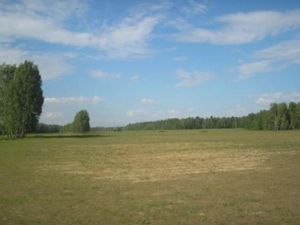In the late 50s, the village of Krivushi was recognized as unpromising. The collective farm of the village was transformed into a brigade and attached to the Pesnic collective farm. In 1959 it was transformed into Krivushy and the village council. The village became part of the Peschansky village council.
The village of Krivushi is an ecologically clean area with a well-developed network of paved roads. In addition to the proximity of the Dnieper, the Krivaya Ruda River flows along the village, connected to the Dnieper by a canal. The village is electrified and radio-connected. Soils – chernozem and sandy loam. Forests grow green on the sands. All this attracts people to this fertile corner.
The invasion of the village began with the allocation of pastures and arable land for summer cottages. Many of the wealthy and influential people are now striving to get a land plot in the village for housing development. And they receive. So, for 1991-1996. in fact, all the arable land of the village was distributed for estates, mainly to “strangers”, not to the inhabitants of the village. In Krivushy there are no pastures for cattle, arable land.
Despite the fact that the village is located in the flood zone from the Kremenchug reservoir (it will be flooded within 30 minutes if the dam breaks), the construction of villas and cottages is proceeding at an accelerated pace. Now there are 2-3 times more new houses in the village than houses inhabited by indigenous people. Rural cemeteries, due to the lack of order on them, have become burial places for anyone and anyone. The possibility of even criminal burials is not ruled out. The cemeteries have already gone beyond the limits of the land allotted for them. The Yatsynivskoye cemetery is expanding especially rapidly. Over a hundred years, it has expanded less than over the past 7-10 years. The indigenous inhabitants of the village began to fence off places for graves for almost the entire clan (family) next to the graves of relatives and friends.
Now the Dnieper River for the villagers is only a water artery, and before the construction of the dam, the Kremenchug hydroelectric power station, the Dnieper village was a source of firewood, fish, and forests. On the island they mowed hay, picked sorrel, blackberries, cut vines, red shelugs, from which they wove baskets, wallets (there was a workshop in the forestry), walked young cattle and horses. There was a lot of game there. The lakes on the island were full of fish. Hundreds of cows and geese were grazed on the floodplains by residents of Reevka, Loboykovka, Yatsynivka, Stalivka, Drobotivka, and other parts of the village,
Particularly great harm to the village was caused by gardening groups that occupied arable land, floodplains. Due to their poor planning, they practically concreted the ground (land plots are 4-6 acres, the roads are narrow, there is no way to pass, there are no development prospects). So disfigured is the land of our ancestors. Summer residents practically cut off the villagers from the beauty and grace of nature, cutting off all roads and paths from the village to the Dnieper, to the forest “Pine” in Zarudya. Now it’s not as easy as before, you can read from the village to the Dnieper and find a place to relax and swim there. Dacha arrays, like fortresses, are fenced and hung with forgiving and warning signs and inscriptions.
The village is on the verge of extinction. There are rumors that in the near future it will become part of the city. If this happens, then the almost 300-year history of the Krivushes will end. Sooner or later it will happen. It is desirable that in the new administrative structure, in the names of streets, public transport stops, the old names of farms – village kutki – be preserved.
Author: Yatsyna Viktor Petrovich
Notes, memories, reflections on the fate of my homeland – p. Krivushi.

